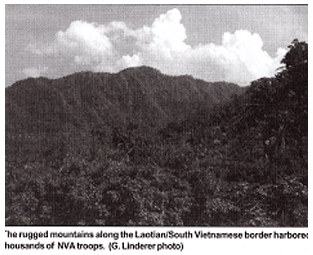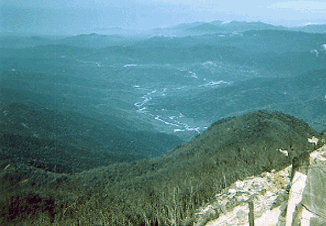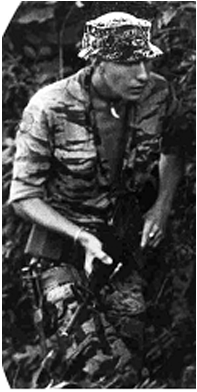 Our commander was Tom Kinane, who had an uncanny ability to look at a topographical map and know where the enemy would be, told us that getting past the fortifications around the valley would be the most dangerous part of our mission. He was right. On several of the high ridges were semi-permanent NVA complexes both above and below ground. It was between two of these fortifications that my squad was ambushed while on patrol. Within two minutes, nine of the eleven men on patrol were wounded. Only the man at the rear of the column and myself were not wounded.
Our commander was Tom Kinane, who had an uncanny ability to look at a topographical map and know where the enemy would be, told us that getting past the fortifications around the valley would be the most dangerous part of our mission. He was right. On several of the high ridges were semi-permanent NVA complexes both above and below ground. It was between two of these fortifications that my squad was ambushed while on patrol. Within two minutes, nine of the eleven men on patrol were wounded. Only the man at the rear of the column and myself were not wounded.
All the enemy had to do to stop the advance of the Americans was to wound a few of us and everything would grind to a halt. A hole would be cut in the jungle to accommodate the medevac helicopters. This gave the NVA time to regroup and better prepare for the advancing Americans.
By the morning of June 3rd, we had worked our way to a point high on a ridge facing north. To the west was the Laotian border, to the east was the wide, open terrain of the valley floor and ahead to the north on the other side of the entrance to the valley was a large mountain. The U.S. military identified it was Hill 937, the Vietnamese called it Dong Ap Bai, and a year later Senator Ted Kennedy named it “Hamburger Hill”.
We assented from the south down the mountain and on to the floor of the A-Shua Valley.
This is where our objective changed from exploring jungle covered mountains; mostly never set foot in by humans before us, to protecting a unit of engineers on one of the most heavily used infiltration routes by the North Vietnamese to bring supplies into the south. The engineer’s task was to lay a mine-field across the northern entrance to the valley.
The valley floor consisted of 8ft. elephant grass but no dense jungle or cover, so it was imperative that this operation be finish as quickly as possible.
Orders came around for 1/327 to find out if there was any enemy activity on Hill 937. D Company led the way followed by C Company in support. Once on the valley floor, our personal security evaporated. For the first time in months, large groups of men were totally exposed no canopy no jungle, no place to hide in this enemy stronghold.
Finally, we reached the other side of the valley and started our ascent. Then D Company started receiving fire from somewhere in front of us. We encountered reinforced bunkers, heavy machine gun and mortar fire from what seemed like every direction, way more fire power than we’d encountered to date. Our orders were to find out if there was enemy activity up there, not to take the hill. As soon as we confirmed the hill was occupied, we left. We returned to our sanctuary on the other side of the valley floor where we called in the Air Force to deal with the mountain stronghold. By the time we returned, the entire battalion was on the valley floor protecting the engineers.
 Left Photo: The A-Shau Valley 1968.
Left Photo: The A-Shau Valley 1968.
For the next three hours, jets dropped napalm; 250-pound bombs and what seemed like everything but nukes on this hill with anti-aircraft and green tracers being returned by the NVA. Never have I seen such bold action taken by the enemy as I did that day. This hill was different from all the mountains we had explored so far because of its strategic location, guarding the Laotian border and the entrance to the valley. To our north and south-west were mountains. To our west the Laotian border and we were standing in the middle of the Ho-Chi-Minh Trail.
Time was crucial and we knew we were being watched from the surrounding mountains. As night was descending the engineers finished their job. As we were preparing to move out we started receiving incoming mortar rounds from the mountains around us then artillery fire from somewhere in Laos. We had to move and the only direction that was open to us was south, straight down the center of the valley.
Our commander was Tom Kinane, who had an uncanny ability to look at a topographical map and know where the enemy would be, told us that getting past the fortifications around the valley would be the most dangerous part of our mission. He was right. On several of the high ridges were semi-permanent NVA complexes both above and below ground. It was between two of these fortifications that my squad was ambushed while on patrol. Within two minutes, nine of the eleven men on patrol were wounded. Only the man at the rear of the column and myself were not wounded.
All the enemy had to do to stop the advance of the Americans was to wound a few of us and everything would grind to a halt. A hole would be cut in the jungle to accommodate the medevac helicopters. This gave the NVA time to regroup and better prepare for the advancing Americans.
By the morning of June 3rd, we had worked our way to a point high on a ridge facing north. To the west was the Laotian border, to the east was the wide, open terrain of the valley floor and ahead to the north on the other side of the entrance to the valley was a large mountain. The U.S. military identified it was Hill 937, the Vietnamese called it Dong Ap Bai, and a year later Senator Ted Kennedy named it “Hamburger Hill”.
We assented from the south down the mountain and on to the floor of the A-Shua Valley.
This is where our objective changed from exploring jungle covered mountains; mostly never set foot in by humans before us, to protecting a unit of engineers on one of the most heavily used infiltration routes by the North Vietnamese to bring supplies into the south. The engineer’s task was to lay a mine-field across the northern entrance to the valley.
The valley floor consisted of 8ft. elephant grass but no dense jungle or cover, so it was imperative that this operation be finish as quickly as possible.
Orders came around for 1/327 to find out if there was any enemy activity on Hill 937. D Company led the way followed by C Company in support. Once on the valley floor, our personal security evaporated. For the first time in months, large groups of men were totally exposed no canopy no jungle, no place to hide in this enemy stronghold.
Finally, we reached the other side of the valley and started our ascent. Then D Company started receiving fire from somewhere in front of us. We encountered reinforced bunkers, heavy machine gun and mortar fire from what seemed like every direction, way more fire power than we’d encountered to date. Our orders were to find out if there was enemy activity up there, not to take the hill. As soon as we confirmed the hill was occupied, we left. We returned to our sanctuary on the other side of the valley floor where we called in the Air Force to deal with the mountain stronghold. By the time we returned, the entire battalion was on the valley floor protecting the engineers.
For the next three hours, jets dropped napalm; 250-pound bombs and what seemed like everything but nukes on this hill with anti-aircraft and green tracers being returned by the NVA. Never have I seen such bold action taken by the enemy as I did that day. This hill was different from all the mountains we had explored so far because of its strategic location, guarding the Laotian border and the entrance to the valley. To our north and south-west were mountains. To our west the Laotian border and we were standing in the middle of the Ho-Chi-Minh Trail.
Time was crucial and we knew we were being watched from the surrounding mountains. As night was descending the engineers finished their job. As we were preparing to move out we started receiving incoming mortar rounds from the mountains around us then artillery fire from somewhere in Laos. We had to move and the only direction that was open to us was south, straight down the center of the valley.
 Left Photo: TJ McGinley.
Left Photo: TJ McGinley.
It was my turn to walk point. Without delay we took off and not at a slow pace. It was getting dark, fast and moving through the elephant grass even though we were being cut to ribbons by the razor sharp blade of this type of vegetation, we could move much quicker than in the dense jungle. After about an hour we slowed down realizing where we were as we came across crumpled barbed wire and rotten sand bags. I knew we had found the abandoned Green Beret camp that was overrun by the NVA in 1966. This put me in my place and I realized what I was doing and where I was, walking point through one of the most dangerous locations on the planet in 1968, the A-Shau Valley in the middle of the night.
I encountered two separate groups of NVA soldiers during our march. Americans never moved at night, so our adversaries didn’t know just what to do when I appeared out of the vegetation, so they ran. Not wanting to broadcast our location. We didn’t give chase or expel too many rounds at the fleeing enemy. I didn’t know the size of the force we had encountered and they didn’t know how many of us there were. It was kind of an instantaneous mutual understanding among adversaries in this very odd situation, to leave well enough alone. Firefights raged all through the valley as encamped units of Americans were being probed by the NVA.
We slowed our pace now that we were out of range of the artillery that was pursuing us. After what seemed like weeks the most beautiful dawn that I can remember started to unfold. We had radioed ahead to an American unit to be expecting our approach from the north. What they saw must have resembled a scene from a Steven King novel. From out of the early morning mist came a unit of ghost soldiers. The elephant grass, which we mostly ignored, had cut us to shreds. We were completely out of food, low on ammo, water, and strength. We had been up for 48 hours and the last eight we had walked, at night, through ten miles of one of the most enemy infested location in all of South Vietnam.
Later that day the First Brigade of the 101st was extracted from the A-Shau Valley after being in the jungle of the Central Highland for more than three months.
During the five day stand-down at Camp Eagle, several members of C, Company including myself, decided to join Tiger Force. It was in this elite group of paratroopers that I first met men who could “out-Indian” the Indians. This recon team consisted of about 30 well-seasoned, handpicked volunteers.